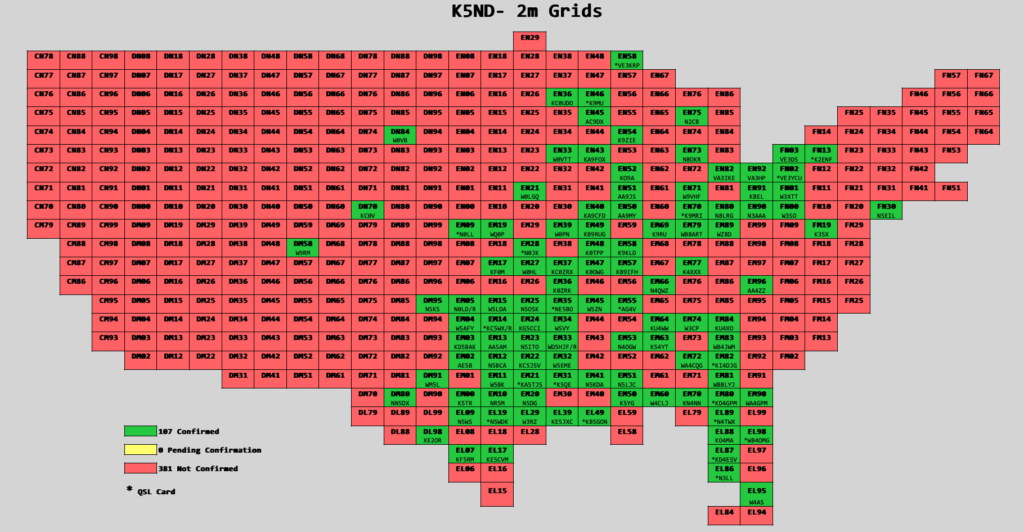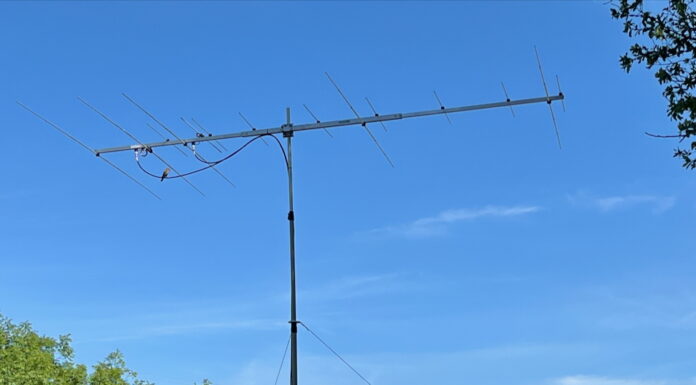My 144 MHz Journey
My journey to 144 MHz VUCC got its start with a tropospheric ducting event in March 2016. With my cheap Yagi at 20 feet or so, I was able to work from here in Texas to the Gulf Coast including Florida. I ended up with 13 grids and five new states.
Of course, when you’re roving during VHF contests it’s impossible to add new grids to your home station’s logbook. But I’ve been fortunate recently with some excellent Tropo and even Sporadic E openings. In nearly every case, I saw the opening and ran out to my patio push-up mast to set up my Directive Systems 2 meter rover yagi.
In September 2020, there was superb Tropo opening into the upper Midwest. I added 20 grids on 144 MHz during that opening, with FT8 making all the difference. That brought my total to 72. Another opening in December 2021 got me to 79 grids.
In June 2021 during ARRL Field Day, a spectacular two-meter Sporadic E opening broke out. I added 20 new grids that day, thanks not only to the opening but to the fact that so many stations were already on the air for Field Day. That brought my total to 99 grids worked.
In the September 2021 VHF Contest I elected to stay home. As a result I was able to add five new grids during some short Tropo openings during that high activity. It also helped that I was able to work a few rovers and some high power contest stations.
Another thing that’s helped my VUCC journey is a new interest from a few rovers in activating rare 2 meter grids in addition to the FFMA 6 meter grid activators. Those efforts added a few MSK144 contacts to my total.
144 MHz Equipment
My equipment power level throughout this journey has generally been at 100 watts. That started via an Icom IC-910H and then an Icom IC-9100. In February 2021 I added a RF Concepts 170 watt amplifier, but mostly operate this at 100 to 150 watts.
For antennas, as noted above I’d previously been using Cheap Yagis and following those a couple years later with a Diamond 5-element Yagi and then 10-element Yagi. In 2018 I added a Directive Systems 2 meter 6-element Rover Yagi with 8-foot boom.
Collecting QSLs
I’ve found it somewhat challenging to collect confirmations on 2 meters. During my grid chases on 6 meters and particularly Satellites, Logbook of the World works great. However, for some reason, collecting 2 meter confirmations has been more challenging.
I’ve sent a lot of cards but received only a few in return. My current VUCC total on 2 meters shows 17 QSL cards with the rest LoTW confirmations.
ARRL Application
Of course, if you’ve got 100 LoTW confirmations submitting a VUCC application is quite easy. Unfortunately, I needed to use QSL cards to get the application to 100.
My application journey began in August 2021 with card checking and mailing the application. I received confirmation that the application arrived when my check cleared the bank on September 2, 2021. I had heard that VUCC applications took a long time. So I patiently waited until December 9, when the QSL confirmations showed up in my LoTW account. This was followed on December 17 with the VUCC award denoted in my same LoTW account. The certificate arrived on January 4, 2022.
It’s all about the journey. Glad to finally get the certificate! Thanks to everyone who added a new grid to my log and who also provided confirmation.
Here’s the USA map of the grids I’ve confirmed. The map is courtesy of Francis, KV5W, and his work supporting FFMA and higher VHF bands with online log tracking tools to support rover grid activation.










Congratulations, Jim!
I am working on the same milestone. If I read the rules correctly, you can add grids from your rover as long as the contacts are made within 200 kilometers of your home QTH. When roving, I use a 200-km circle map to help plan to remain within the circle as much as possible on my route. I can run just south of OKC and a few miles north of DFW from my location in EM04rb.
VUCC Rules:
6. For VUCC awards on 50 through 1296 MHz and Satellite, all contacts must be made from locations no more than 200 km apart. For SHF awards, contacts must be made from a single location, defined as within a 300-meter diameter circle.
Thanks, Korey. It’s nice to reach that milestone operating from home. I’d like to get 222 and 432 as well. But not sure my station has that capability and I don’t want to invest in it either.
I decided to operate from home for VUCC awards rather than involve the rover operations. Although, that makes great sense as a motivator to get out there and work more grids.
Unfortunately, I think the VUCC rules needs some deep legal interpretation at times. The rules say, as you quote above “all contacts much be made from locations no more than 200 km apart.” That would imply a circle map with a diameter of 200 km, not a radius of 200 km. As I read it, one location can’t be greater than 200 km from any other eligible location.
Of course, as they say “your mileage may vary” and it certainly applies in this case.
I hope to work you during the January VHF contest. I’ll be operating from my home station.
73, Jim, K5ND
This is a very late reply :-). I did make a mistake in my description and have a 200-meter radius map centered on my location.
[…] always about improving your operation and, for me, chasing more grids. Having earned 2-meter VUCC, I want to take a few station improvement steps to add more grids. Plus, since I’ve shut down […]